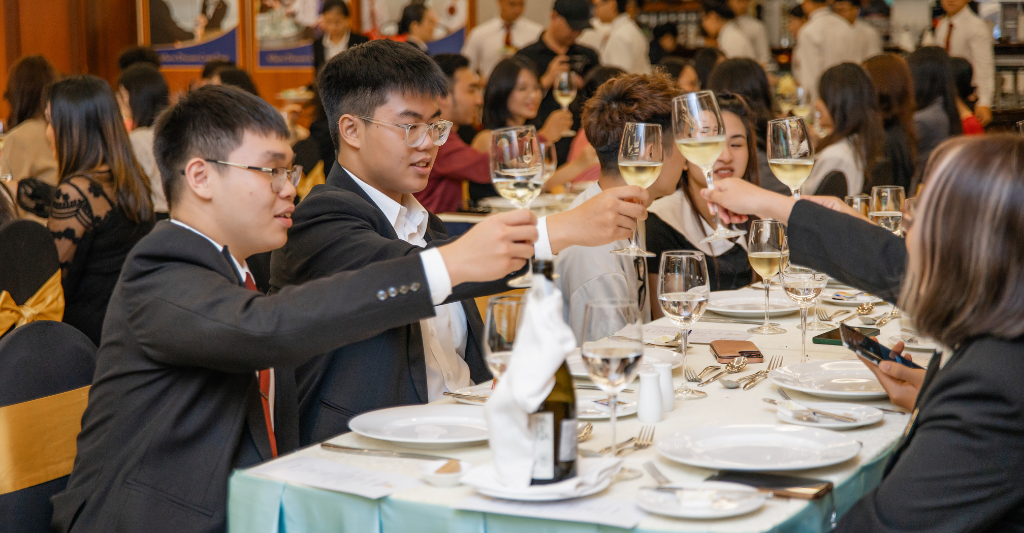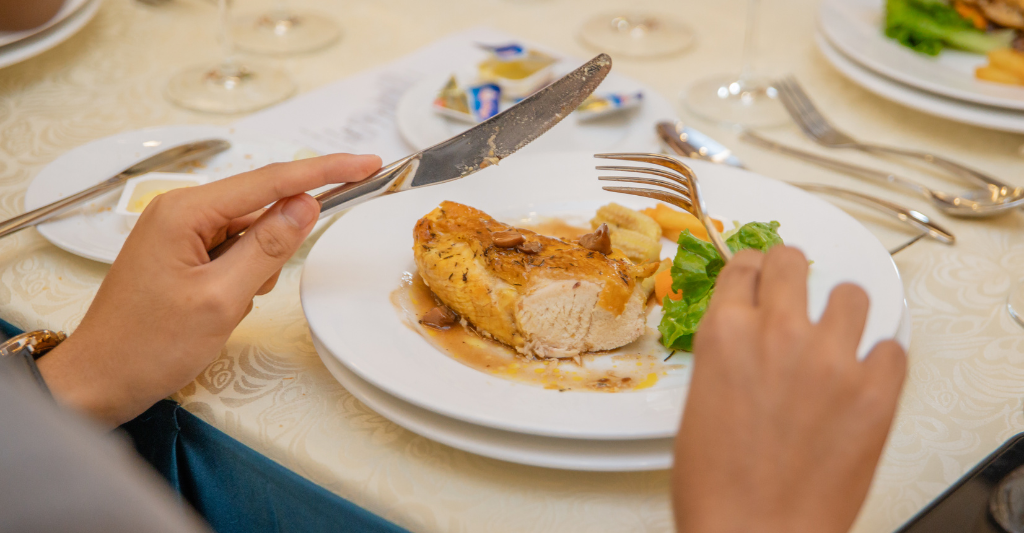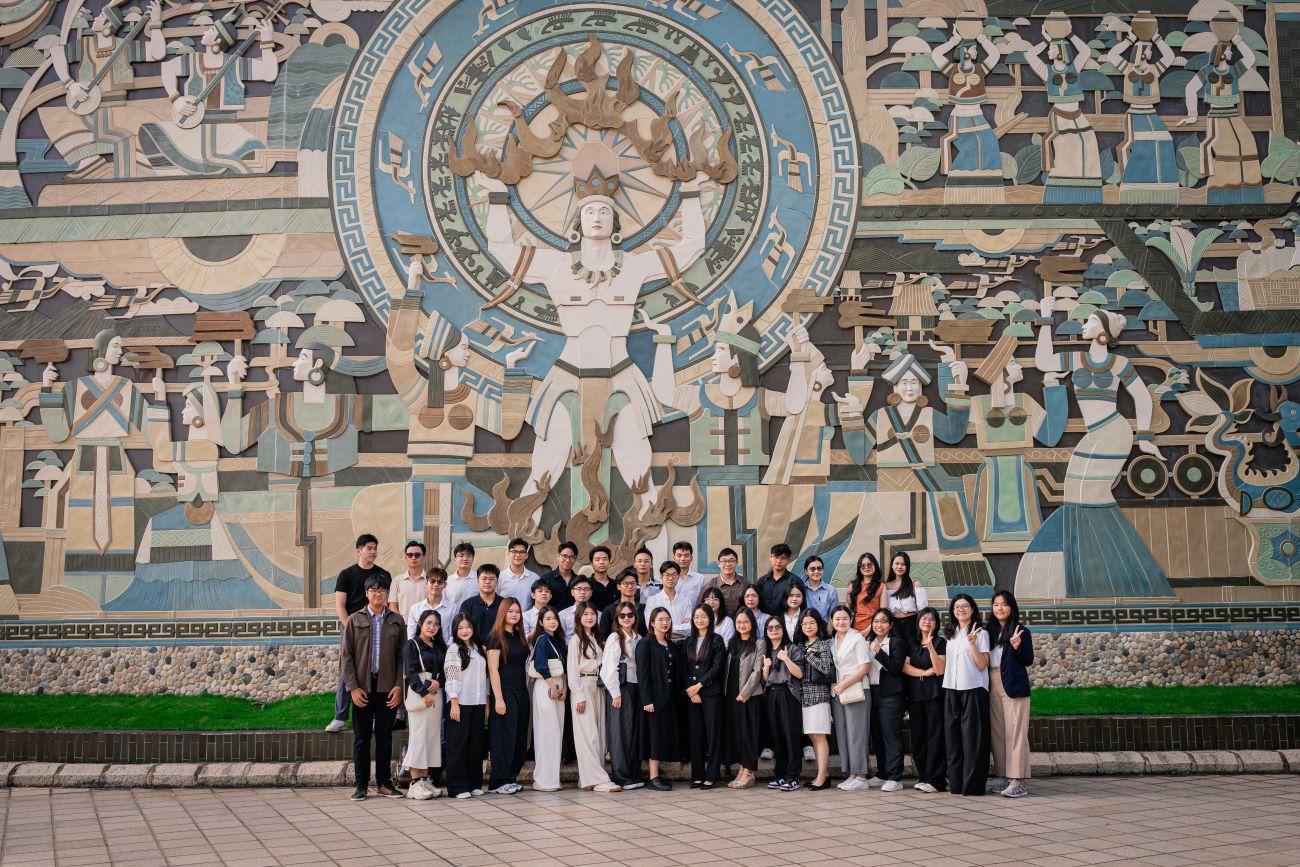LQT Table Manners & Dinner Etiquette Class – 10 Dining Etiquette Rules for Businessmen
Diplomatic events, intimate meetings with partners, and impromptu meals can be considered a daily routine for a businessman. To practice professionalism and the necessary hard skills when dealing with unexpected situations at the dinner table, LQT Business Bachelor students participated in the LQT Table Manners & Dinner Etiquette Class, under the guidance of Dr. Ly Qui Trung at the 5-star Saigon Tourist restaurant, and the practical part was guided by representatives of Saigon Tourist.
10 Dining Etiquette Rules
In the LQT Table Manners & Dinner Etiquette Class, Dr. Lý Quí Trung highlights 10 fundamental dining etiquette rules every businessman should remember:
Rule 1: Dress Appropriately
Dress is the first factor to evaluate the other person at the party. Dressing appropriately for the context helps the wearer easily integrate into the party atmosphere. Dr. Ly Qui Trung emphasized that, if possible, check in advance the participation form (format), meeting place (place) and desired dress color (dress-code) of the party. In particular, we often encounter 3 dress styles in the following specific situations:
- First meetings with partners or networking events: Business Smart
- Important meetings or interviews: Business Formal
- Casual dinners: Business Casual
Refer to the details of Business Smart, Business Formal and Business Casual styles through the article 05 business dress styles

Rule 2: Be Punctual
Show yourself as a serious and professional person by always showing up 5 minutes before the scheduled meeting. To do this, students need to check the route in advance, prepare for possible situations such as traffic jams, weather, etc. Additionally, Dr. Ly Qui Trung emphasized that the ideal time to arrive at a scheduled meeting point is between 5 to 15 minutes early. Arriving too far in advance may be inappropriate, while being even slightly late is absolutely unacceptable.
Rule 3: Respect Cultural Differences
Understanding the culture of the people at the party can also help avoid awkward situations. For example, in Western culture, pulling out a chair for a woman is not only not a sign of chivalry, but also an insult to women. Instead, a man can open the window where he is sitting and pour the first glass of wine for the other person.
Rule 4: Choose Your Meal Wisely
Mr. Trung said that you should not order dishes that make you look “messy” when enjoying them, such as hamburgers, crabs, etc. Instead, opt for dishes that can be easily managed with standard table cutlery, like salads or pasta, to maintain a neat and professional dining experience.
Next, you should not choose the most expensive dish on the menu, but choose dishes in the average price range. Most importantly, for important parties, do not come with an “empty stomach”. Eat a snack at home beforehand so that during the party you are not dominated by food, and at the same time have a good “spirit” to be ready to communicate and respond to people around you.
Rule 5: Initiate Conversation
This is an important rule in the 10 rules of table manners, taking the initiative to talk is a way to help you score points in the eyes of the other person, this also proves the confidence from your inner self. Some typical topics used to start a conversation include: travel and family.
Topics that are often avoided during meals are sensitive topics that can easily cause division and debate, including: money, religion, and politics.

Rule 6: Master Your Body Language
Dr. Lý Quí Trung lists several body language tips to enhance your presence at the table:
- Sit upright
- Keep both feet flat on the floor
- Avoid placing elbows on the table
- Place your napkin on your lap upon sitting
- If leaving the table temporarily, place your napkin on your chair
- Don’t eat hastily or talk with your mouth full
- Refrain from using utensils to point at others
- Avoid putting the soup spoon directly into your mouth
These are also basic mistakes that participants often make when doing things incorrectly or doing the opposite, unintentionally creating a bad impression in the eyes of those around them.
Rule 7: Use Utensils Correctly
Use the utensils outside and work your way up to different dishes:
- Fork to the left of the plate, knife and spoon to the right
- There are 2 types of knives: long knife for main courses, medium knife for salad, small knife for dessert and the smallest knife for butter
- Large fork for main courses, smaller fork for salad and smallest for seafood dishes like oysters or mussels
- Fish knives will have a flat blade and a pointed tip (for separating bones…)

How to signal to the waiter when you are finished eating?
- Leave your utensils (knife and fork) aside when taking a break or waiting for more food
- Place your utensils side by side at the 4 o’clock position and napkin on the table to the left of your plate when you are finished eating
Rule 8: The BMW Rule
BMW is a combination of 3 elements that are always present on every dining table: Bread – Meal and Water. This theory shows that bread and butter are always on your left, food in the middle and water on the right. Remembering this principle will help you keep the right position of the food on the table during the meal.
Rule 9: Wait for other before start eating
Number 9 in the top 10 rules of table manners for business people is the rule of eating only when everyone else has started eating. In other words, before starting to eat, wait for everyone’s food to be served.
If the host intends to invite you to eat first, have a small piece of bread while waiting for others to eat.
Rule 10: Express Gratitude for the Occasion
At the end of the meal, it’s important to sincerely thank your host for the invitation and express how honored you were to be part of the gathering. Share your appreciation for the opportunity to meet and dine with the other guests, and if appropriate, take a moment to exchange business cards to maintain future connections.
Wrapping up the experience
At the end of the LQT Table Manners & Dinner Etiquette course with 10 rules of conduct at the dinner table, along with a simulation practice of an intimate party at the 5-star Saigon Tourist restaurant right after that on the application of tableware and wines, LQT students were fully equipped with hard skills on how to communicate at the dinner table and “sharpen” soft skills in real-life situations.
 Tiếng Việt
Tiếng Việt English
English



